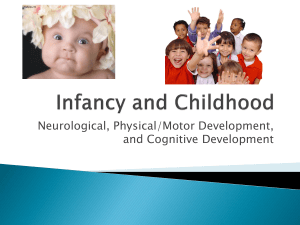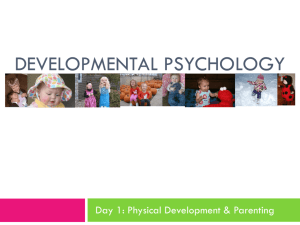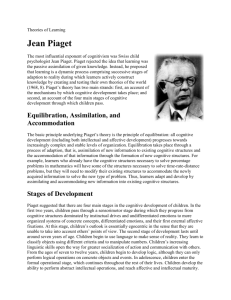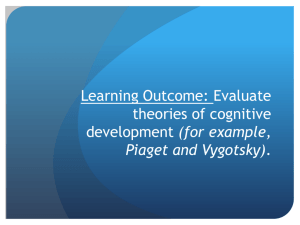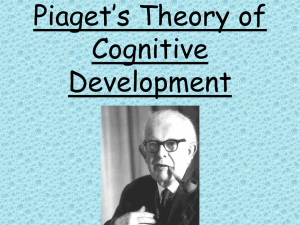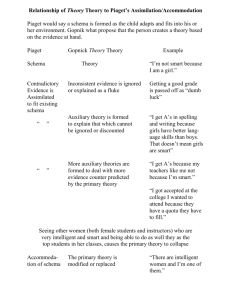Cognitive Development in Children
advertisement
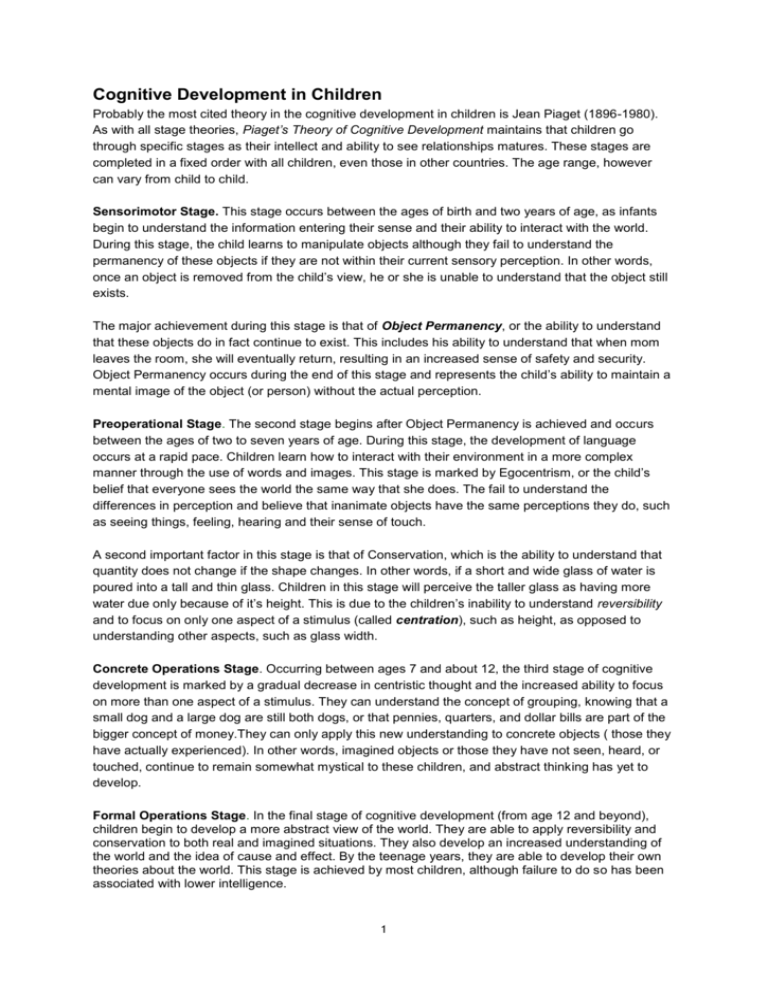
Cognitive Development in Children Probably the most cited theory in the cognitive development in children is Jean Piaget (1896-1980). As with all stage theories, Piaget’s Theory of Cognitive Development maintains that children go through specific stages as their intellect and ability to see relationships matures. These stages are completed in a fixed order with all children, even those in other countries. The age range, however can vary from child to child. Sensorimotor Stage. This stage occurs between the ages of birth and two years of age, as infants begin to understand the information entering their sense and their ability to interact with the world. During this stage, the child learns to manipulate objects although they fail to understand the permanency of these objects if they are not within their current sensory perception. In other words, once an object is removed from the child’s view, he or she is unable to understand that the object still exists. The major achievement during this stage is that of Object Permanency, or the ability to understand that these objects do in fact continue to exist. This includes his ability to understand that when mom leaves the room, she will eventually return, resulting in an increased sense of safety and security. Object Permanency occurs during the end of this stage and represents the child’s ability to maintain a mental image of the object (or person) without the actual perception. Preoperational Stage. The second stage begins after Object Permanency is achieved and occurs between the ages of two to seven years of age. During this stage, the development of language occurs at a rapid pace. Children learn how to interact with their environment in a more complex manner through the use of words and images. This stage is marked by Egocentrism, or the child’s belief that everyone sees the world the same way that she does. The fail to understand the differences in perception and believe that inanimate objects have the same perceptions they do, such as seeing things, feeling, hearing and their sense of touch. A second important factor in this stage is that of Conservation, which is the ability to understand that quantity does not change if the shape changes. In other words, if a short and wide glass of water is poured into a tall and thin glass. Children in this stage will perceive the taller glass as having more water due only because of it’s height. This is due to the children’s inability to understand reversibility and to focus on only one aspect of a stimulus (called centration), such as height, as opposed to understanding other aspects, such as glass width. Concrete Operations Stage. Occurring between ages 7 and about 12, the third stage of cognitive development is marked by a gradual decrease in centristic thought and the increased ability to focus on more than one aspect of a stimulus. They can understand the concept of grouping, knowing that a small dog and a large dog are still both dogs, or that pennies, quarters, and dollar bills are part of the bigger concept of money.They can only apply this new understanding to concrete objects ( those they have actually experienced). In other words, imagined objects or those they have not seen, heard, or touched, continue to remain somewhat mystical to these children, and abstract thinking has yet to develop. Formal Operations Stage. In the final stage of cognitive development (from age 12 and beyond), children begin to develop a more abstract view of the world. They are able to apply reversibility and conservation to both real and imagined situations. They also develop an increased understanding of the world and the idea of cause and effect. By the teenage years, they are able to develop their own theories about the world. This stage is achieved by most children, although failure to do so has been associated with lower intelligence. 1 STAGE AGES DEVELOPMENTAL CHANGES Sensorimotor Birth to 2 years Gradual emergence of mental representation, and gradual progression from reflexive to goaldirected behavior. The major achievement is object permanence. 2 to 7 years Ability to represent objects symbolically. However, children still lack ability to manipulate objects mentally. Therefore, they are unable to solve problems like conservation, which require mentally reversing processes (e.g., pouring liquid from one container to another). Preoperations 7 to 11 Concrete Operations years Formal Operations Ability to employ operational thinking. Now children are able to not only represent objects mentally, but also operate upon objects mentally. Therefore, they have mastered conservation problems (e.g., volume, mass, and number). They have also mastered tasks like seriation (logical arrangement of objects), transivity (inferred relationships between objects), and class inclusion. Yet, earthbound thinking generally precludes abstract thought. Adolescents and adults are able to think abstractly about hypothetical situations; they 11 years to are no longer earthbound thinkers. Therefore, adulthood they can engage in hypothesis testing, reasoning even in absence of direct experience. Piaget's stage theory describes the cognitive development of children. Cognitive development involves changes in cognitive process and abilities. In Piaget’s view, early cognitive development involves processes based upon actions and later progresses into changes in mental operations. Key Concepts Schemas - A schema describes both the mental and physical actions involved in understanding and knowing. Schemas are categories of knowledge that help us to interpret and understand the world. In Piaget's view, a schema includes both a category of knowledge and the process of obtaining that 2 knowledge. As experiences happen, this new information is used to modify, add to, or change previously existing schemas. For example, a child may have a schema about a type of animal, such as a dog. If the child's sole experience has been with small dogs, a child might believe that all dogs are small, furry, and have four legs. Suppose then that the child encounters a very large dog. The child will take in this new information, modifying the previously existing schema to include this new information. Assimilation - The process of taking in new information into our previously existing schema’s is known as assimilation. The process is somewhat subjective, because we tend to modify experience or information somewhat to fit in with our preexisting beliefs. In the example above, seeing a dog and labeling it "dog" is an example of assimilating the animal into the child's dog schema. Accommodation - Another part of adaptation involves changing or altering our existing schemas in light of new information, a process known as accommodation. Accommodation involves altering existing schemas, or ideas, as a result of new information or new experiences. New schemas may also be developed during this process. Equilibration - Piaget believed that all children try to strike a balance between assimilation and accommodation, which is achieved through a mechanism Piaget called equilibration. As children progress through the stages of cognitive development, it is important to maintain a balance between applying previous knowledge (assimilation) and changing behavior to account for new knowledge (accommodation). Equilibration helps explain how children are able to move from one stage of thought into the next. 3
